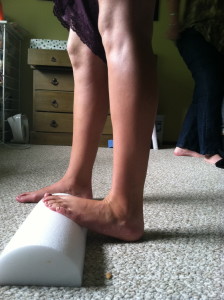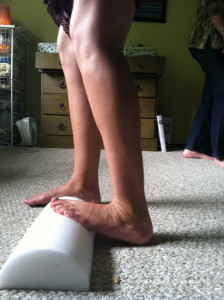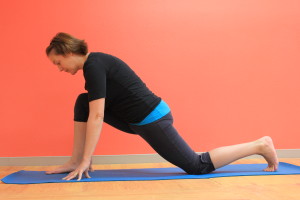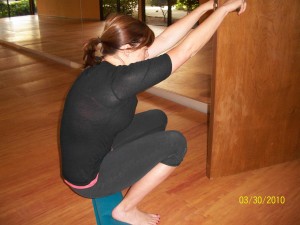This article, originally written March 2013, was a follow up to You Don't Know Squat, originally written in 2010. Both have been updated and expanded a bit in February 2020 to include new resources and commentary. For more on pelvic floor health, read Our Best "Healthy Pelvis" Resources.
You Don't Know Squat has generated more questions than any other article I've written, so below addresses some of these FAQs and includes some of the stuff I wish had been in the first post.
On squat-prepping exercises:
The first half of the original squat post is squat-prep exercises. If you've been wearing shoes and sitting in chairs your entire life, there is a strong chance your body cannot squat (right now) in a way that doesn't create excessive pressure or pain. This is why squat-prep exercises are so beneficial and perhaps more important than the squat itself.
How long should I do these exercises for?
Don't underestimate the amount of time you need to Calf Stretch. If you've been wearing conventional shoes for three decades or more, and mostly walk on flat and level terrain, you will need to do the calf stretch for at least 27 years. A day. You need to stretch your calves 27 years a day. If that sounds like a lot, then start out trying to get this movement in at least a few times a day.
How do the calf muscles affect the squat?
Calf Stretch
When it comes to squatting, the tighter the calves, the more keeping your heels down while squatting is a challenge. All squat lovers should first be lovers of the Calf Stretch.
Soleus Stretch
The Calf Stretch only gets one chunk of the muscles affecting a squat; there's another that can target the deeper calf muscles that make it impossible to get your heels down. Add this Soleus Stretch (a.k.a. the other calf stretch) to your squat-prep moves. Once you've stepped up on the dome, bend the knee of your stretching leg to move the stretch toward your ankle.
Are there other squat-prep moves to try?
Lunges
Add a pelvis-untucking lunge to your squat-prep moves. A lunge is like a one-legged squat, and in a lunge, you can practice lengthening the front leg's hamstring—in the way it would need to lengthen during an untucked squat. The nice thing about a lunge is you can practice untucking while unloaded and one leg at a time. In the case of this particular lunge, you're trying to line up the pelvis with the front thigh (in other versions, I'd have you lunge with a tucked pelvis). Bonus points for a vertical front shin.
The "pelvic floor" squat
A squat done in any way can be beneficial. But the squat I am trying to teach here is one that better uses the glutes, which, as they contract, can create a tensile load to the sacrum, which in turn can give a stretch to the pelvic floor, helping these muscles work eccentrically (generation while lengthening vs. while shortening).
The indicator of whether a squat is using the front of the body (think all quads) or the back of the body (think glutes and hamstrings) is shin position. The closer the knee joint is to stacking over the ankle joint and the more untucked the pelvis, the more glute contraction you’ll use. The more the knees move in front of the ankle and the more tucked the pelvis, the less glute contraction you’ll use.
Door/Supported Squats
If you want to put your squats "behind you," use a door for support. Holding on to a doorknob (a sign pole also works) walk backwards until your arms are extended. Feel free to prop your heels as in the squat moves in You Don't Know Squat.
Then, move your knees back, until they're aligned with your ankles, which should help untuck your pelvis. 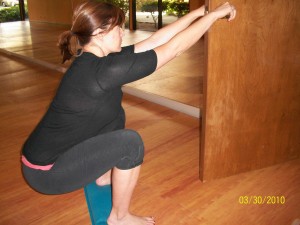
You might have to move your feet a few times to get to the place where you feel your backside kicking in (for what it's worth, we typically start with our feet too close to the door). Initially the arms will be doing a lot of work; they're standing in for glute strength. If you feel like you'd totally launch backward if the door suddenly gave way, your feet are likely too close to the door--walk back a bit and try again.
And, P.S. You can also practice your vertical-shin technique when you get up out of chairs and off of the toilet.
How should I work on doing squats?
In addition to the exercises in the original squat post, you can start trying to come up and down with more vertical shins and see how far you can go down before the knees have to move. You can work from the bottom, squatting with forward knees and trying to untuck your pelvis and back your knees up as you rise. You can work from the top, only going down as far as you can hold yourself while trying to bring your knees back. Most people will find the range of motion of their "glute squat" to be fairly small, which is fine. You can increase the glute-active range of your squat with time (more specifically, doing exercises over time; just getting older doesn't work), especially if you’re working on changing the habits like where you hold your pelvis throughout the day and how often you use furniture.
Do I need to do 200 squats a day?
No. In fact, if you're currently doing zero, it's better to do only a few squats and a ton of squat-prep stretching. It's the squat prep that helps you orient your pelvis so that your glutes are working while you're walking around doing other stuff. If you're only working your muscles for that 20-60 minutes a day, it's not enough.
Which part of the squat is valuable?
The down part. The up part. And the part in the middle. Gluteal action is primarily used on the way up. However, lingering in a squat, especially if you can kind of relax, helps the muscles and involved joints change their tension patterns.
What if my stomach is too big to squat with?
Go wider with your knees. But, that doesn't automatically mean that you have to turn the feet out. Turning the feet out is a way to reduce the need for some of the calf muscles to lengthen for a squat. This is why a lot of us, including me, can squat better when they turn out. (If you check out your arch when you squat with feet turned out, you're likely to see that you're actually rotating your shank, typically losing the arch in the foot. Look up "schmear" in Whole Body Barefoot for more on that.)
Is a squat ever a no-no?
Many men and women, either post–pelvic floor surgery (slings or hernia repairs, especially) or when you're realllllllly pregnant, will be advised to not squat. Is it because there is a problem with a squat itself? Not really. The problem is, when we don't have strength to do something, we'll often create momentum. And, in the case of hauling your body weight up from the ground, a normal response to momentum is a bearing down movement. This bearing down creates down/outward ward pressure inside, which can exacerbate your issue (read Diastasis Recti for more on pressure forces and hernias and organ prolapse). In these cases, start with all of the squat-prep exercises where the downward pressure is not an issue.
And, as long as you're not on bed rest or advised not to exercise, and are still getting up and down out of chairs, you can follow the chair squat video for better butt-building form.
Squats and the bigger picture
Many readers have ended up here because of what they've read about squatting and pelvic-floor issues. As I explain more in Move Your DNA, there's a host of natural human movements that are part of a well-functioning pelvic floor (one that can respond to the loads that are fluctuating with positional changes). If I had to boil it down to three movement types, I'd say walking, squatting, and hanging all contribute to balanced forces as far as the pelvis's muscles go. I'd also work to reduce sitting on a tucked pelvis.
And, for what it's worth: I’ve gotten a lot of mail over the years from you readers, telling me that you're better, both mentally and physically, because of learning how to move differently. I just wanted to let you know that this phenomenon goes both ways. Because of you, I've grown to understand my own work better and wanted to thank you for letting me grow in this forum.
Want more squatting exercises? Read You Don't Know Squat and check out my 2017 squat-themed exercise advent for 24 squat moves. Read Move Your DNA for more information on squatting and natural movement. If you like to listen to learn, Podcast Episode #91 is all about the squat. If you're wanting more simple exercises to make your hips, pelvis, and lower back more supple, check out Nutritious Movement for a Healthy Pelvis.

